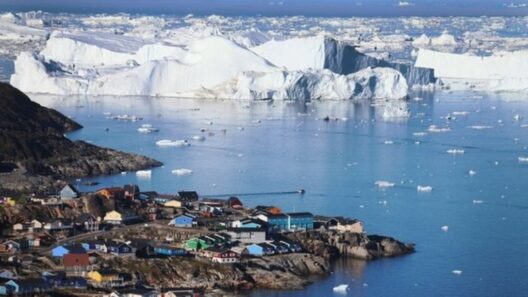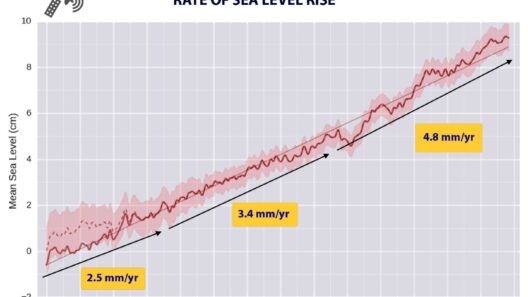Rising sea levels have emerged as one of the most formidable challenges of our time, casting a looming shadow over communities, economies, and ecosystems. This phenomenon is not simply an environmental issue; it is a multifaceted crisis that has profound implications for global infrastructure and human habitation. Why is there growing concern surrounding this issue? The reasons lie not only in observable trends but also in the intricate interplay of climatic, geological, and socio-economic factors.
The phenomenon of rising sea levels is predominantly driven by two intertwined processes: thermal expansion of seawater as it warms and the melting of ice sheets and glaciers. As global temperatures rise due to climate change, the consequences become evident. The simple act of warming water leads to expansion, while the melting of vast ice reserves in Greenland and Antarctica injects colossal volumes of freshwater into the oceans. This combination has driven sea levels up, with some estimates projecting a rise of over three feet by the end of the century under the most adverse scenarios. Such projections beg the question: what does this imply for coastal regions and their infrastructure?
Throughout history, the seas have been revered for their beauty and bounty; however, as they creep steadily higher, they incite anxiety rather than admiration. Coastal cities, which are often cradled between land and sea, face existential threats. The infrastructure that supports millions—such as roads, bridges, and public transit systems—is increasingly vulnerable to inundation. From New York City to Jakarta, urban planners are grappling with the challenge of designing resilient systems that can withstand the creeping encroachment of the tides. Yet many cities remain caught in the crosshairs of economic growth and environmental sustainability. Delaying action could exacerbate repair and retrofit costs, potentially straining municipal budgets and diverting resources from other critical needs.
The implications extend beyond physical damage. Rising sea levels can catalyze severe socioeconomic upheaval. As coastal areas become less habitable, populations may be compelled to relocate. This migration can foster tensions over resources and ignite conflicts—particularly in regions where arable land is dwindling. The phenomenon not only threatens those living at the water’s edge but also reverberates through economies and social fabrics, affecting markets, labor forces, and local cultures. The intersection of climate change and migration necessitates a broader understanding of socio-political resilience amidst environmental adversity.
The Spillover Effects: Ecological Consequences of Coastal Flooding
Rising sea levels are not merely a matter of urban infrastructure; they are also a harbinger of ecological disruption. Coastal ecosystems—including salt marshes, mangroves, and coral reefs—serve as natural buffers against storms and act as nurseries for myriad marine species. As the seas rise, these habitats are under siege. Saltwater intrusion can decimate freshwater supplies and adversely affect agriculture in nearby regions. This dual threat—erosion of habitats and loss of natural barriers—could have far-reaching implications for biodiversity and fish stocks, which are vital for food security across the globe.
Moreover, as human activity disturbs natural ecosystems, the cascading effects come into focus. Species that depend on coastal environments may face extinction unless these habitats are preserved or restored. Biodiversity loss has wider implications, too, affecting everything from pollination to disease regulation. Thus, the issue of rising sea levels transcends immediate adaptations. It is about the long-term viability of our planet’s ecological systems, which support life in all its forms.
Innovations in Adaptation: Engineering Solutions and Community Resilience
Confronting the challenges posed by rising sea levels requires both innovation and ingenuity. Cities are increasingly adopting a variety of strategies to bolster resilience, ranging from seawalls and levees to “living shorelines” that enhance natural barriers. Reimagining urban landscapes has become imperative; green roofs, rain gardens, and permeable pavements not only mitigate flooding but also foster biodiversity and improve air quality. These solutions reflect a shift towards sustainability, recognizing that engineered solutions must work in tandem with natural systems to create communities capable of withstanding the pressures of climate change.
Furthermore, public awareness and community engagement play a pivotal role in fostering resilience. Citizens—armed with knowledge about the risks associated with rising sea levels—can drive demand for thoughtful policies and sustainable practices. Educational initiatives can empower communities to advocate for smart development, ensuring that infrastructures are built with foresight, adaptability, and sustainability in mind.
Global Collaboration: Policy and Governance for Climate Action
Addressing the challenges posed by rising sea levels necessitates a collective approach. Climate change knows no borders, and the solutions will require cooperation across nations, sectors, and communities. Concerted efforts to develop comprehensive climate adaptation strategies, robust financial frameworks, and inclusive policies can fortify global infrastructure and enhance resilience to sea level rise. Moreover, international collaborations, such as the Paris Agreement, are essential for setting ambitious greenhouse gas emission reduction targets, thus addressing the root causes of climate change. Each nation must recognize its role in both the problem and the solution.
Ultimately, the growing threat of rising sea levels calls for urgent attention and action. It is not merely an environmental crisis but a complex convergence of socio-economic, ecological, and infrastructural challenges that require innovative solutions, strong governance, and community resilience. As societies are thrust into this reality, the imperative of embracing sustainability becomes abundantly clear. The journey toward adapting to rising oceans will test our ingenuity, resolve, and collective responsibility to safeguard both our planet and future generations.








